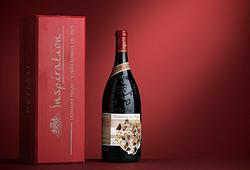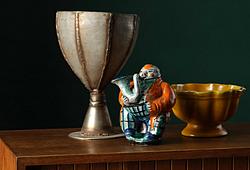Anna Petrus
Four cast iron reliefs, Näfveqvarn, Sweden, pieces of a table designed for the Metropolitan exhibition in New York 1927.
Partly black painted, decorated with a man and a woman's head and a plant loop, two of the reliefs stamped SWEDEN and marked A. Petrus. Each relief 85 x 25 cm, mounted to a modern dark stained wooden base with a carrara marble top, 230 x 115 cm, total height 88 cm.
Wear.
Saleroom notice
Droit de suite (d).
Provenance
The Director's villa, Näfveqvarns Bruk, Nyköping, thence in descent.
Exhibitions
The reliefs are most probably the legs to one of the three original tables, exhibited at the "Swedish Contemporary Decorative Arts" at the Metropolitan Museum of Arts in New York 1927.
One of these three tables was also shown at the Stockholm exhibition in 1930.
Literature
Gregor Paulsson (ed), Svenska Slöjdföreningens Tidskrift, Stockholm 1927, häfte 2, see pp 25-37.
Christian Björk, "Näfveqvarns Bruk - Konstnärer och arkitekter till industrin", Orosdi-Back 2013, the tables depicted from the New York Exhibition 1927, p 107, as well as details and sketches pp 104-105, see also the model depicted from the Stockholm Exhibition 1930, p 163.
The Carl Bergsten archives, ArkDes, Stockholm, see Carl Bergsten's scetch with the three Anna Petrus tables for the exhibition at the Metropolitan Museum of Arts in New York 1927.
More information
Three tables were made for the Swedish Exhibition of Decorative arts at the Metropolitan Museum in New York in 1927. Following the success in Paris 1925, Sweden, as a single nation, was for the first time invited to attend an art exhibition at the Metropolitan Museum of Arts in New York. The exhibition opened January 17 in the presence of H.K.H. Prince Wilhelm and Sweden's Envoy in Washington, Mr Wolman Boström. The exhibition was a success, and in the SSF's Journal (Form) in 1927 Gregor Paulsson writes that "reportedly no exhibition has had such a publicity in the daily New York newspapers. The number of visitors was very large. The highest number of visitors on a day was 6000 people, which is a record at the Metropolitan Museum". Invitations came later to move the exhibition to other cities in the United States, including Detroit and Chicago. After the Stockholm exhibition in 1930, where one of the tables was shown, the tables were put away and this table was mounted apart.
Designer
Anna Petrus was a sculptor, industrial designer, and artist active in the early 20th century. She was born as Anna Petersson, the daughter of a professor of medicine and a countess, and adopted her surname while studying at the Royal Academy of Fine Arts. She inherited a modest fortune at the age of 11 when her mother passed away, which allowed her to pursue her education in London and travel to Italy and France.
Anna Petrus's major international breakthrough came with the Exposition Internationale des Arts Décoratifs et Industriels Modernes in Paris in 1925, where she showcased items in pewter and cast iron, in the Swedish Grace style. Pewter was considered an outdated material at the time, but its popularity grew as designers like Petrus recognised its advantages. In 1924, she began a collaboration with the then newly established Firma Svenskt Tenn. The lion became a recurring motif in Anna Petrus's work, both as sculptures and as stylised decorations.
Read more


















































































